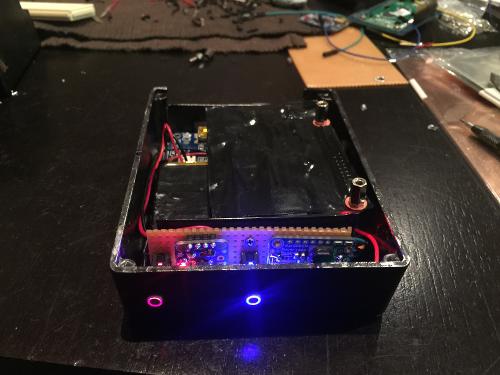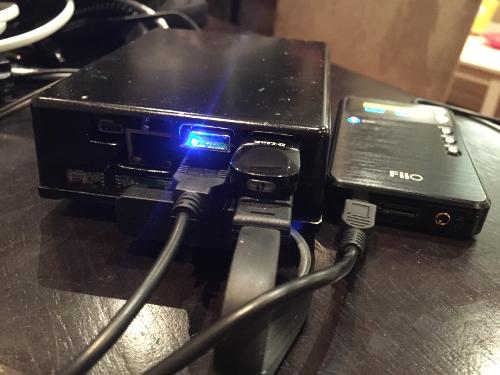Hiltonk
100+ Head-Fier
- Joined
- May 8, 2014
- Posts
- 168
- Likes
- 243
Hi All,
I've designed and built a new all aluminium case for the RPi2 B and wanted to check interest here in such a case if I were to sell the design and list of components online, or mass produce it as a completed unit and sell it.
It started out as just a personal project as there isn't a case like this in the market and I thought maybe others would like it?
I designed and built it to run JRiver Media Center to have a portable bit perfect audio player that can run headless without any monitors etc. (JRiver has an experimental build for Arm out that I've been using which may also get video support in the future if they follow what's been done for the Linux build)
It would suite anyone wanting an all in one media player that has internal HDD and optional rechargeable battery.
It's not much bigger than a standard Pi case, however it has:
An internal lithium ion rechargeable battery with about 5-6hrs of charge. (maybe more I still haven't formally timed it, it's at least 5hrs)
A slot removable HDD up to 2TB 9.5mm (or SSD and will take the thinner 7.5mm drives too).
All the USB, Ethernet, HDMI and power ports on the rear.
Headphone/Lineout on the front. (ok I know the standard analog out isn't great but it's usable for non critical listening)
Power LED and switch on the front.
You can plug the HDD into a computer as a standard USB 3 Drive to load it up with content.
The HDD is removable through a slot without disassembling the case.
It's still in prototype stage but it's 95% complete and will have a few other changes in the final version;
More GPIO controls and buttons to control the media player.
Reboot and shutdown button.
Restart media player button.
Maybe an internal 2ch DAC if I can workout how to fit one.
A better heatsink and passive cooling design.
Battery LED charge/charging status.
Still a couple of cables to sort out for HDMI and a micro SD card ribbon extender to relocate the SD card so you can get to it without taking it apart.
Still have to finish the rear panel.
It's all aluminium to help dissipate the heat and to give that solid feeling you just cant get with plastic.
I'm going for the FiiO look and it actually looks pretty good even in it's raw aluminium state but it will be either painted or anodised black with a brushed metal finish.
I've been developing this for a few weeks since the RPi2 came out and it works well as a desktop media player or in the car, or just outside paired with a BT speaker or DLNA renderer. (or streaming bit perfect 96/24 FLAC to your iPhone/Android with JRemote via wifi personal hotspot or via a portable USB DAC such as the FiiO E17)
So what are peoples thoughts?? Would you buy one completely assembled, or as a kit, or the specs and plan to build it yourself?
Demo




I've designed and built a new all aluminium case for the RPi2 B and wanted to check interest here in such a case if I were to sell the design and list of components online, or mass produce it as a completed unit and sell it.
It started out as just a personal project as there isn't a case like this in the market and I thought maybe others would like it?
I designed and built it to run JRiver Media Center to have a portable bit perfect audio player that can run headless without any monitors etc. (JRiver has an experimental build for Arm out that I've been using which may also get video support in the future if they follow what's been done for the Linux build)
It would suite anyone wanting an all in one media player that has internal HDD and optional rechargeable battery.
It's not much bigger than a standard Pi case, however it has:
An internal lithium ion rechargeable battery with about 5-6hrs of charge. (maybe more I still haven't formally timed it, it's at least 5hrs)
A slot removable HDD up to 2TB 9.5mm (or SSD and will take the thinner 7.5mm drives too).
All the USB, Ethernet, HDMI and power ports on the rear.
Headphone/Lineout on the front. (ok I know the standard analog out isn't great but it's usable for non critical listening)
Power LED and switch on the front.
You can plug the HDD into a computer as a standard USB 3 Drive to load it up with content.
The HDD is removable through a slot without disassembling the case.
It's still in prototype stage but it's 95% complete and will have a few other changes in the final version;
More GPIO controls and buttons to control the media player.
Reboot and shutdown button.
Restart media player button.
Maybe an internal 2ch DAC if I can workout how to fit one.
A better heatsink and passive cooling design.
Battery LED charge/charging status.
Still a couple of cables to sort out for HDMI and a micro SD card ribbon extender to relocate the SD card so you can get to it without taking it apart.
Still have to finish the rear panel.
It's all aluminium to help dissipate the heat and to give that solid feeling you just cant get with plastic.
I'm going for the FiiO look and it actually looks pretty good even in it's raw aluminium state but it will be either painted or anodised black with a brushed metal finish.
I've been developing this for a few weeks since the RPi2 came out and it works well as a desktop media player or in the car, or just outside paired with a BT speaker or DLNA renderer. (or streaming bit perfect 96/24 FLAC to your iPhone/Android with JRemote via wifi personal hotspot or via a portable USB DAC such as the FiiO E17)
So what are peoples thoughts?? Would you buy one completely assembled, or as a kit, or the specs and plan to build it yourself?
Demo























